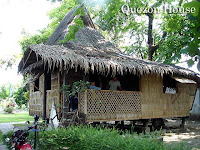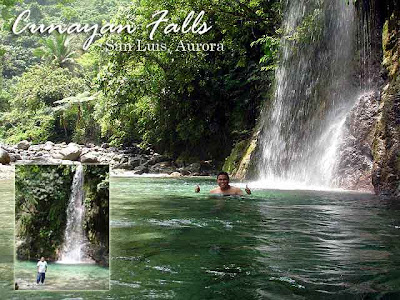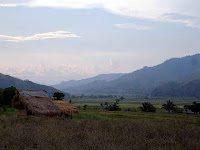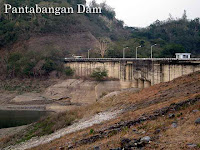
The waves were strong yesterday morning when we woke up. It was perfect for surfing! For breakfast, I ordered the Big Surf Special at the restaurant which was a choice of sausage, ham or hotdogs with hash browns, toasted bread and scrambled eggs. It came with coffee and juice as well. But I was expecting a bigger serving of meat though. Anyway, we left the hotel at 9 a.m. to go around Baler.

Our first stop was the Church of Baler, a national historical landmark, because it had been the site of the last stand of Spanish forces in the country. As the Siege of the Church of Baler marker mentions, a Spanish garrison of four officers and fifty men was besieged in the church by Filipino forces from June 27, 1898 to June 2, 1899. The had refused demands for surrender for nearly a year and only did so when an emissary of General Rios dropped a newspaper from Manila inside the court of the church to let them know that for many months the Spanish flag was no longer waving in Luzon except that of Baler Church. The fortitude of the garrison was praised by President Emilio Aguinaldo in a public document issued on June 20, 1899.

In front of the church stands the Aragon House, the birthplace of Doña Aurora Aragon Quezon, wife of President Manuel L. Quezon. It's not the
bahay na bato type but the small wooden ones that you would expect from a remote fishing town. If travel is difficult today, imagine how it was then. I never knew that Doña Aurora and President Quezon were first cousins since their Molina mothers were sisters! Also don't forget that Aurora province was named in her honor which is why it's very important to preserve this house.

We then drove to the park a few meters away which was the birthplace of Quezon. Aside from an NHI marker and a statue, they had erected a replica of the
nipa hut of the Quezon family. Also in the park was a museum but we didn't enter since we had to rush to San Luis, our next stop, to visit Kaunayan (Cunayan) Falls in Brgy. L. Pimentel.
Our original plan was to visit Ditumabo Falls but it was closed due to a government project which I hope maintains the beauty of the falls and its surroundings. Anyway, the trip from Baler to Kaunayan Falls was about 30 minutes. As we exited the national highway, it was rough road again but not that far. Since we had to pass through private property to get to the falls, there was a PHP20 "toll" collected close to the falls. At the falls, each person is charged a PHP10 entrance fee.

Kaunayan was not that high. But the clear water was so enticing for a swim. After exploring the streams around it, I decided to go for a dip. The water was cool, close to cold in fact, and perfect for the hot summer day. And the water wasn't deep so you could stand directly below the falls with ease. After a little over an hour, we decided to make our way back since we wanted to try out one last thing.

There are a few just a few popular surfing areas in Luzon. And Baler is one of them! So we tried out surfing. We had arranged for an instructor to give us lessons at 7 a.m. but he didn't show up which was a pity since it was already low tide by the time we got back. But despite the fact that the waves weren't strong, we still asked the tourism staff to arrange tutorials for us even just for an hour so we could give it a try. The rate was PHP300 per hour inclusive of board rentals. They have daily rates too which would be cheaper if you planned to learn surfing the whole day.

Well, it wasn't easy. Balancing on the board was quite difficult at first. And given that we only had an hour, we didn't get to stand. The waves also didn't have enough force to push the board up. But it was still fun! And we plan to come back for longer tutorials.

We had to rush since our plan was to depart Baler by 2 p.m. So after freshening up, we had lunch again at Bay's Inn, which was pizza and breaded garlic chicken this time. We took a different route back to Manila, the one via Pantabangan which was suggested to us since the buses pass by there. But we felt that the road we took the other day was a bit better. Ever since the typhoon which damaged newly-concreted parts of the Bongabon route, the government had stopped concreting that road and focused on this other route. So maybe in a few more months, the drive via the Pantabagan would be a bit faster and more comfortable since the road was wider. But for now, it was longer!

From Baler, we passed through Maria Aurora which is the only Aurora municipality without a coastline. We passed through a lot of rice fields. But the longer drive was as we went up and down the Sierra Madre mountains, again on rough road. On this side, the mountains seemed higher and it was refreshing looking at the picturesque views of lush forests. But this route had more signs of human habitation than the other one and if measures are not undertaken to protect the forests in this area, we might lose it in the next few years. It was sad looking at patches of mountains charred by "slash and burn" farmers. In fact, some parts were still smoking. If the DENR is really doing its job, it should educate these people and implement the law by prosecuting violators since this practice is rampant all over the country.

At the provincial boundary, we were greeted by a lake which seemed to be created by a dam. We actually thought this was part of the Pantabangan Dam but Pantabangan was still far away. The next town after Maria Aurora was Alfonso Castañeda which is already part of Nueva Vizcaya. We wanted to make it to Pantabangan before sundown so that we could check out the Pantabangan Dam. And we got there just in time to take photos of the picturesque lake created by the dam. By the time we exited the dam area, the sun was gone.

We had a late dinner in Cabanatuan City and arrived in Manila at 11 p.m. More photos in
Multiply.
 I was at Far Eastern University (FEU) today for a campus tour with Ivan ManDy and all I could say is that the Art Deco buildings designed by Pablo Antonio, National Artist for Architecture, and the collection of art around campus are fantastic! I never thought that amidst the chaos of Recto and Quezon Boulevard is an oasis, a well-planned campus very conducive to learning. The designs of the new buildings are brilliant and blend perfectly with the old. The campus planners of DLSU should get lessons from the efficient use of space and the elegant designs and arrangement of buildings in FEU. It's no surprise the campus was recognized by UNESCO for heritage conservation.
I was at Far Eastern University (FEU) today for a campus tour with Ivan ManDy and all I could say is that the Art Deco buildings designed by Pablo Antonio, National Artist for Architecture, and the collection of art around campus are fantastic! I never thought that amidst the chaos of Recto and Quezon Boulevard is an oasis, a well-planned campus very conducive to learning. The designs of the new buildings are brilliant and blend perfectly with the old. The campus planners of DLSU should get lessons from the efficient use of space and the elegant designs and arrangement of buildings in FEU. It's no surprise the campus was recognized by UNESCO for heritage conservation. As Ivan ManDy writes: "The Far Eastern University, located in Manila's chaotic and overcrowded University Belt, is the proverbial rose in a sea of thorns. Years of neglect... led to the [campus] falling into hard times, hardly a fit place to inspire the minds of our country's future [leaders]. But then the FEU administration decided... to roll up its sleeves and do something. In one fell swoop, [the campus] morphed from an uninviting, graffiti-infested, makeshift patchwork of classrooms, food-areas and dingy business stalls to [restore itself to] the gleaming Art Deco complex worthy of educating the best minds of the country.
As Ivan ManDy writes: "The Far Eastern University, located in Manila's chaotic and overcrowded University Belt, is the proverbial rose in a sea of thorns. Years of neglect... led to the [campus] falling into hard times, hardly a fit place to inspire the minds of our country's future [leaders]. But then the FEU administration decided... to roll up its sleeves and do something. In one fell swoop, [the campus] morphed from an uninviting, graffiti-infested, makeshift patchwork of classrooms, food-areas and dingy business stalls to [restore itself to] the gleaming Art Deco complex worthy of educating the best minds of the country. "This is the FEU campus today, a touch of architectural class in a city that seems to have forgotten how beautiful she once was. That the university... is in the midst of one of the most high-density and polluted districts of the city did not deter FEU from battling urban blight head on. But what particularly makes the FEU campus noteworthy is that it proved to many how old buildings do not have to mean derelict and unfashionable. In fact they [the restored buildings] are hip and cool..."
"This is the FEU campus today, a touch of architectural class in a city that seems to have forgotten how beautiful she once was. That the university... is in the midst of one of the most high-density and polluted districts of the city did not deter FEU from battling urban blight head on. But what particularly makes the FEU campus noteworthy is that it proved to many how old buildings do not have to mean derelict and unfashionable. In fact they [the restored buildings] are hip and cool..." "Buildings in the FEU campus were constructed between 1930-1950; they had been mostly designed by National Artist Pablo Antonio. Felipe Mendoza designed the other campus structures, notably the chapel. All of campus structures were restored to their original appearance. All new buildings were designed in a contemporary style compatible with the old. Without resorting to architectural mimicry of the heritage architecture, the new blended perfectly with the old."
"Buildings in the FEU campus were constructed between 1930-1950; they had been mostly designed by National Artist Pablo Antonio. Felipe Mendoza designed the other campus structures, notably the chapel. All of campus structures were restored to their original appearance. All new buildings were designed in a contemporary style compatible with the old. Without resorting to architectural mimicry of the heritage architecture, the new blended perfectly with the old." One of the details which I liked were the bronze sculptures around the flagpole done by another National Artist Vicente Manansala. The quadrangle itself is well-planned with the Philippine flag serving as the center of life in campus. Also check out the "Stations of the Cross" murals of National Artist Carlos "Botong" Francisco in the chapel, and the sculpture murals of Francesco Monti and Art Deco mural of Simon Saulog both in the administration building. Watch out for the Old Manila Walks tour of FEU soon. More photos in Multiply.
One of the details which I liked were the bronze sculptures around the flagpole done by another National Artist Vicente Manansala. The quadrangle itself is well-planned with the Philippine flag serving as the center of life in campus. Also check out the "Stations of the Cross" murals of National Artist Carlos "Botong" Francisco in the chapel, and the sculpture murals of Francesco Monti and Art Deco mural of Simon Saulog both in the administration building. Watch out for the Old Manila Walks tour of FEU soon. More photos in Multiply.











